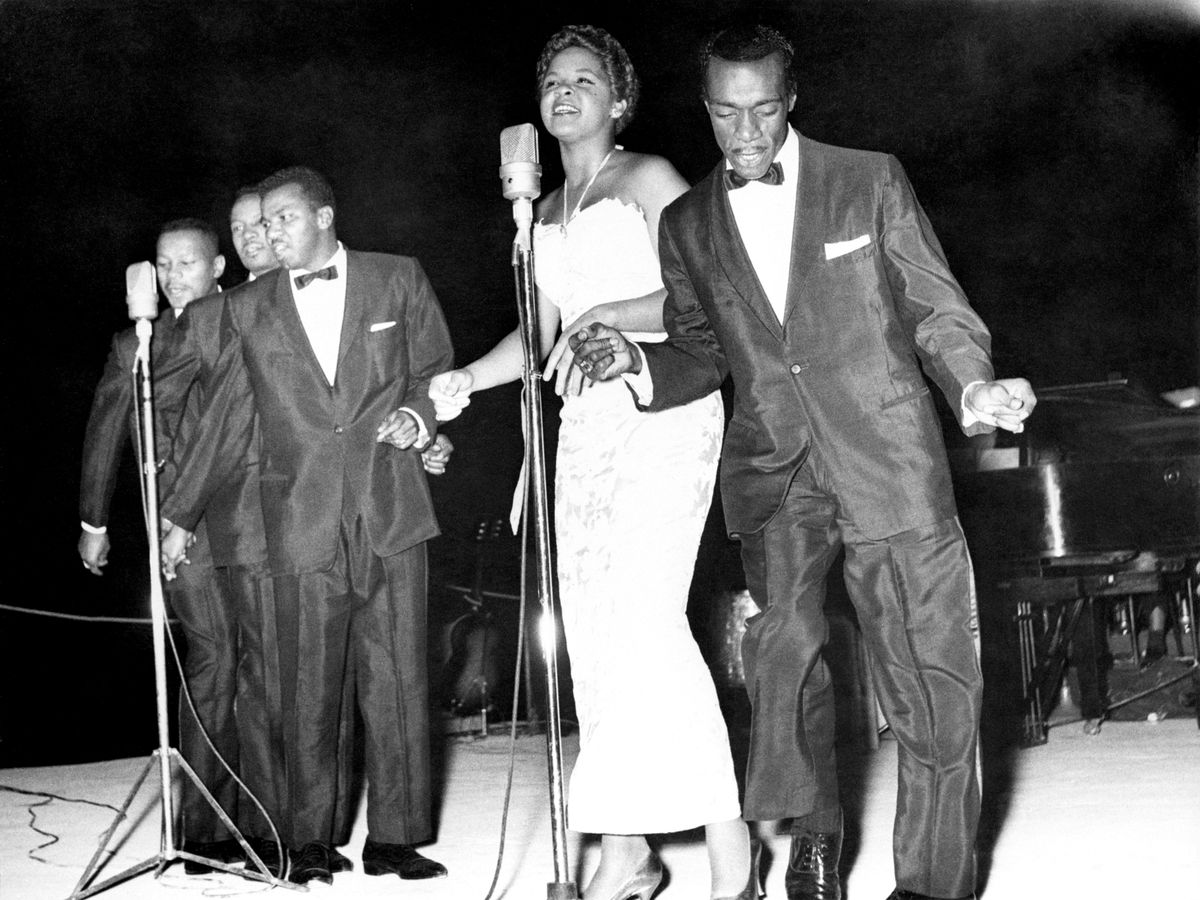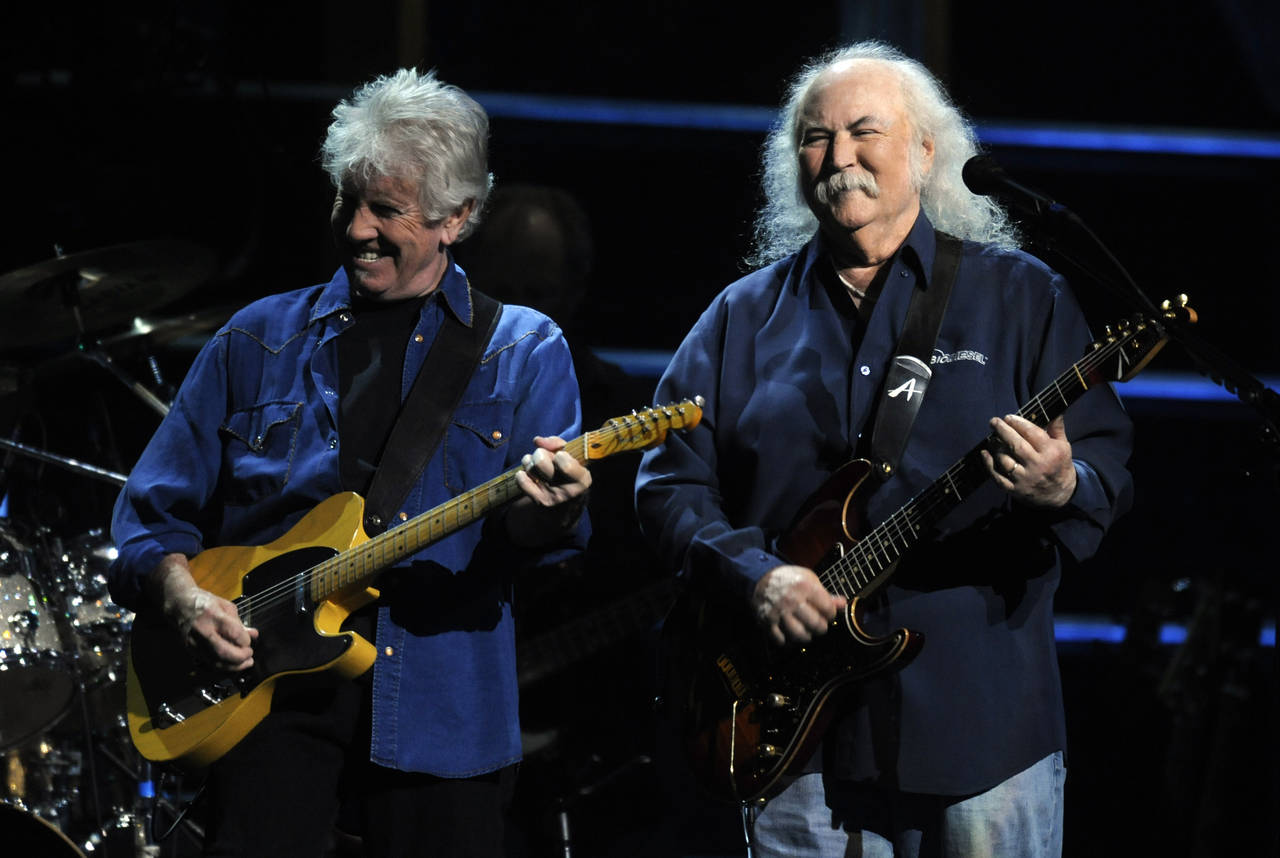

Rock
Who Started Rock And Roll Music
Published: November 5, 2023
Discover the origin of rock and roll music and the pioneers who started this iconic genre. Explore the early influences and evolution of rock.
(Many of the links in this article redirect to a specific reviewed product. Your purchase of these products through affiliate links helps to generate commission for AudioLover.com, at no extra cost. Learn more)
Table of Contents
- Introduction
- Early Influences of Rock and Roll
- African-American Roots of Rock and Roll
- Rhythm and Blues Influence on Rock and Roll
- Country and Western Influence on Rock and Roll
- Key Figures in the Development of Rock and Roll
- Chuck Berry and the Birth of Rock and Roll
- Rock and Roll’s Expansion and Evolution
- Conclusion
Introduction
The origins of rock and roll music can be traced back to the early 1950s in the United States. It emerged as a groundbreaking genre that revolutionized popular music and captured the hearts of millions of people worldwide. Rock and roll was more than just a style of music; it represented a cultural movement that challenged societal norms and gave a voice to the youth of the time.
With its energetic rhythms, electric guitars, and catchy melodies, rock and roll took the world by storm. It was a blend of various musical genres, incorporating elements of rhythm and blues, country and western, and jazz. The birth of rock and roll marked a significant turning point in music history, setting the stage for the emergence of countless legendary artists and bands.
This article will delve into the early influences of rock and roll, highlighting the African-American roots and the fusion of rhythm and blues and country and western music. We will also explore the key figures who played a vital role in the development and popularization of this iconic genre. From the pioneers like Chuck Berry and Elvis Presley to the trailblazers of the British invasion, rock and roll paved the way for a multitude of musical movements and subgenres.
Join us on this musical journey as we go back to the roots of rock and roll, unraveling the stories behind its creation, and exploring the evolution of this dynamic and influential genre of music.
Early Influences of Rock and Roll
The birth of rock and roll was not an isolated event, but the result of the blending of various musical influences that came before it. To understand the roots of rock and roll, we need to look back at the early twentieth century and the diverse genres that laid the foundation for this groundbreaking musical movement.
African-American music played a significant role in shaping rock and roll. The vibrant sounds of blues, gospel, and jazz provided the rhythmic and melodic elements that would later define the genre. African-American artists, facing discrimination and segregation, used music as a means of self-expression and cultural identity.
Another key influence on rock and roll was rhythm and blues (R&B). R&B emerged in the 1940s as a genre that combined blues, jazz, and gospel music. It featured a lively rhythm section, soulful vocals, and an emphasis on improvisation. R&B artists like Louis Jordan, T-Bone Walker, and Big Joe Turner paved the way for the energetic and dynamic performances that would come to define rock and roll.
Country and western music, often referred to as country music, also played a significant role in the development of rock and roll. With its heartfelt lyrics, acoustic guitar-driven melodies, and strong emphasis on storytelling, country music resonated with audiences across America. Artists like Hank Williams, Sr., and Jimmie Rodgers infused their music with a raw emotional intensity that would later find its way into the heart of rock and roll.
In the 1950s, these diverse influences began to merge, setting the stage for the birth of rock and roll. It was a time of social change, where young people were seeking a form of music that spoke to their experiences and emotions. They found it in the fusion of African-American rhythms, R&B’s grooves, and country music’s storytelling.
The early influencers of rock and roll paved the way for a new era of music that would captivate the world. Their contributions, coupled with the energy and rebellious spirit of the youth, laid the foundation for a genre that would go on to redefine popular music and leave an indelible mark on the cultural landscape.
African-American Roots of Rock and Roll
The African-American community played a vital role in shaping the sound and soul of rock and roll. Deeply rooted in the African musical traditions brought to America during the era of slavery, African-Americans incorporated their unique rhythms, vocal styles, and storytelling techniques into the early stages of rock and roll.
One of the key influences on rock and roll was the blues. Originating in the Mississippi Delta, the blues arose as a form of expression for African-Americans in the late 19th century. With its emotional lyrics, soulful vocals, and distinctive guitar playing, the blues captured the hardships and joys of everyday life. Legendary blues artists like Robert Johnson, Muddy Waters, and B.B. King laid the groundwork for the intense emotions and raw energy that would later define rock and roll.
Gospel music also played a significant role in the development of rock and roll. African-American churches served as both spiritual and social centers, and gospel music was an integral part of worship. With its passionate vocals and energetic rhythms, gospel music inspired and influenced many rock and roll artists. The vocal prowess and emotional delivery of gospel singers like Mahalia Jackson and Sister Rosetta Tharpe provided a blueprint for the powerful performances of rock and roll frontmen.
Jazz, the quintessential American art form, seamlessly blended influences from African and European musical traditions. African-American jazz musicians like Louis Armstrong and Duke Ellington showcased their virtuosity and improvisational skills, which would later find their way into the solos and instrumental breaks of rock and roll songs.
Rock and roll was greatly indebted to the African-American community for its transition from niche genres like rhythm and blues and gospel to a mainstream phenomenon. African-American artists faced significant adversity and discrimination during this time, yet their contributions to the genre cannot be overlooked or underestimated.
Without the African-American roots of rock and roll, the genre would lose its raw energy, emotional depth, and cultural significance. It is essential to acknowledge and appreciate the immense influence and impact that African-American musicians had on the development and success of rock and roll.
Rhythm and Blues Influence on Rock and Roll
In the 1940s and 1950s, rhythm and blues (R&B) emerged as a genre that would heavily influence the development of rock and roll. R&B was born out of a blend of blues, jazz, gospel, and boogie-woogie, and it became a seedbed for innovation and creativity in music.
At its core, R&B featured a pulsating rhythm section, powerful vocals, and soulful melodies. Artists like T-Bone Walker, Louis Jordan, and Roy Brown brought a fresh energy and groove to the music scene, setting the stage for the eventual rise of rock and roll.
One of the key aspects of R&B that influenced rock and roll was its lively and propulsive beat. The infectious rhythm, usually driven by a swinging piano or a boisterous saxophone, captivated listeners and had them moving to the music. This rhythmic foundation would later become a hallmark of rock and roll’s power and energy.
R&B also introduced electric guitars and innovative playing techniques. Artists like Chuck Berry, Bo Diddley, and Ike Turner embraced the electric guitar, adding a new level of excitement and virtuosity to their performances. Their groundbreaking guitar work, characterized by catchy riffs, solos, and dynamic stage presence, became a defining element of rock and roll.
Vocally, R&B artists brought soul, passion, and raw emotion to their performances. Singers like Ruth Brown, Etta James, and Ray Charles stunned audiences with their powerful, expressive voices. Their vocal stylings, which blended elements of gospel and blues, paved the way for the soulful and dynamic vocal deliveries of rock and roll legends like Elvis Presley and Little Richard.
Rhythm and blues also played a significant role in breaking down racial barriers in the music industry. While racial segregation was still prevalent during this time, R&B music gained popularity among audiences of all backgrounds. The infectious rhythms and relatable themes transcended race and brought people together through the power of music.
As rock and roll emerged in the 1950s, it borrowed heavily from the rhythms, melodies, and spirit of R&B. The infectious energy, electrifying performances, and boundary-pushing innovation of R&B laid the foundation for the birth and evolution of rock and roll as a genre that impacted the world of music and popular culture.
Country and Western Influence on Rock and Roll
Country and western music, often referred to as country music, played a significant role in shaping the development of rock and roll. Country music’s heartfelt lyrics, emotional storytelling, and distinctive sound resonated with audiences across America, offering a different perspective to the music landscape of the time.
Country music originated in rural America, telling tales of love, heartbreak, and everyday life. Artists like Hank Williams Sr., Jimmie Rodgers, and Patsy Cline became synonymous with country music, capturing the essence of the genre with their soul-stirring vocals and poignant songwriting.
One of the key influences of country music on rock and roll was the emphasis on storytelling. Country songs often centered around relatable narratives, weaving tales of heartache, perseverance, and the struggles of everyday people. This emphasis on storytelling would later find its way into the lyrics and songwriting of rock and roll artists, adding a depth of emotion and connection to their music.
The use of acoustic guitars and simple chord progressions were also characteristic of country music. This simplicity and authenticity carried over to early rock and roll, providing a foundation for the genre’s distinctive sound. Rock and roll pioneers like Elvis Presley, Carl Perkins, and Jerry Lee Lewis drew inspiration from the raw and organic nature of country music, infusing their own unique style into the evolving genre.
Country music’s influence on rock and roll extended beyond just musical elements. The rebellious nature of many country songs resonated with the youth of the time, who were seeking a form of musical expression that reflected their own discontent and desire for change. Songs like Johnny Cash’s “Folsom Prison Blues” and Merle Haggard’s “Okie from Muskogee” spoke to the frustrations and sentiments of a generation, laying the groundwork for rock and roll’s spirit of rebellion and counterculture.
As rock and roll continued to evolve, it incorporated more elements of electric guitars, driving rhythms, and energetic performances. However, the influence of country music remained present, with artists continuing to draw inspiration from its storytelling tradition and distinctive sound.
The fusion of country and western with rhythm and blues and other diverse influences created a musical landscape that defined the birth of rock and roll. The blending of these genres helped shape the dynamic and ever-evolving nature of rock and roll, making it a truly unique and influential genre in the history of music.
Key Figures in the Development of Rock and Roll
Rock and roll would not have become the iconic genre it is today without the contributions of several key figures who played pivotal roles in its development. These individuals shaped the sound, style, and cultural impact of rock and roll, leaving a lasting legacy that continues to resonate with music lovers around the world.
One of the most influential figures in the early days of rock and roll was Chuck Berry. With his electrifying guitar riffs, catchy melodies, and charismatic stage presence, Berry was a true pioneer of the genre. Songs like “Maybellene” and “Johnny B. Goode” epitomized the spirit and energy of rock and roll, inspiring countless musicians and becoming essential classics of the genre.
Elvis Presley, often referred to as the “King of Rock and Roll,” brought rock and roll to the mainstream. With his unique singing style, provocative stage performances, and magnetic personality, Presley became a cultural icon and helped bridge the gap between black and white audiences. His hits like “Heartbreak Hotel” and “Hound Dog” reshaped popular music and established rock and roll as a global phenomenon.
Little Richard, known for his flamboyant style and thrilling piano playing, also left an indelible mark on rock and roll. Songs like “Tutti Frutti” and “Long Tall Sally” showcased his energetic vocals and infectious energy, influencing generations of artists with his exuberant stage presence and unforgettable hooks.
Bill Haley and his band, The Comets, were instrumental in bringing rock and roll to a wider audience. Their hit song, “Rock Around the Clock,” became an anthem for the rebellious youth of the 1950s and played a significant role in popularizing the genre across different demographics.
The influence of female artists on rock and roll cannot be overlooked. Pioneers like Wanda Jackson, Janis Joplin, and Aretha Franklin broke boundaries and shattered stereotypes with their powerful voices and fierce performances, paving the way for future generations of female rock stars.
The British invasion of the 1960s, led by bands like The Beatles, The Rolling Stones, and The Who, brought a fresh and innovative approach to rock and roll. Their groundbreaking music, blending elements of rock, pop, and rhythm and blues, transformed the genre and further expanded its cultural significance.
These are just a few of the many key figures who played integral roles in the development of rock and roll. Their contributions, whether through their musical innovations, stage presence, or cultural impact, shaped the genre into what it is today and continue to inspire new generations of musicians to push the boundaries of rock and roll even further.
Chuck Berry and the Birth of Rock and Roll
When it comes to the birth of rock and roll, one name stands out: Chuck Berry. Dubbed the “Father of Rock and Roll,” Berry’s innovative guitar playing, charismatic stage presence, and vibrant songwriting revolutionized the face of popular music.
Berry’s unique blend of blues, country, and rhythm and blues created a distinctive sound that would come to define rock and roll. His energetic guitar riffs, often punctuated with his signature “duck walk” dance move, electrified audiences and brought a new level of excitement to the genre.
Songs like “Maybellene,” “Johnny B. Goode,” and “Roll Over Beethoven” became instant classics, showcasing Berry’s storytelling prowess, catchy melodies, and playful lyrics. His songs resonated with young people, capturing the exuberance and rebellious spirit of a generation seeking a new music that reflected their experiences.
Berry’s influence extended far beyond his own record sales. His innovative guitar techniques, including bending strings and incorporating double stops, paved the way for future generations of rock guitarists. Artists like Keith Richards, Jimi Hendrix, and Angus Young have all acknowledged Berry as a major influence on their own playing styles.
Alongside his musical contributions, Berry’s lyrics captured the teenage experience like never before. His songs tackled topics like school, cars, and young love, relating to the struggles and aspirations of his audience. This lyrical approach established a connection between the artist and his fans, further solidifying rock and roll as the voice of the youth.
In addition to his musical talents, Berry’s charisma and stage presence were unparalleled. His energetic performances and animated storytelling captivated audiences and set a new standard for live shows. Berry’s influence as a performer cannot be underestimated, as he introduced an element of showmanship that would become an integral part of rock and roll culture.
Despite facing his fair share of challenges, Chuck Berry’s impact on music and pop culture is immeasurable. He paved the way for rock and roll to become a worldwide phenomenon, inspiring generations of musicians and shaping the future of popular music.
Chuck Berry’s contributions to rock and roll continue to be celebrated and revered. His distinctive sound, immersive storytelling, and captivating performances laid the groundwork for a genre that would rock the world and leave an enduring legacy. Without Chuck Berry, rock and roll, as we know it, simply wouldn’t exist.
Rock and Roll’s Expansion and Evolution
Since its inception in the 1950s, rock and roll has undergone a remarkable expansion and evolution, continually redefining itself and pushing musical boundaries. The genre’s ability to adapt and incorporate new influences has allowed it to remain relevant and exciting throughout the years.
One of the most significant developments in the expansion of rock and roll was the British Invasion of the 1960s. Bands like The Beatles, The Rolling Stones, and The Who burst onto the scene, introducing a fresh and innovative approach to the genre. They merged elements of rock, pop, and rhythm and blues, creating a sound that captivated audiences worldwide. This influx of British bands solidified rock and roll’s global reach and expanded its cultural impact.
The 1970s witnessed the emergence of various subgenres within rock and roll. From the raw energy of punk rock with bands like The Ramones and The Sex Pistols to the introspective and poetic lyrics of artists like Bob Dylan and Bruce Springsteen, rock and roll continued to evolve in both sound and lyrical content.
The 1980s saw the rise of stadium rock and the integration of new wave and synthesizers into the genre. Bands like U2, Bon Jovi, and Duran Duran dominated the airwaves, infusing rock and roll with a larger-than-life sound that filled arenas and stadiums around the world.
In the 1990s, the alternative rock movement took center stage, challenging the mainstream with its raw and angsty sound. Bands like Nirvana, Pearl Jam, and Soundgarden brought a new level of authenticity and introspection to rock and roll, capturing the frustrations and disillusionments of a generation.
The turn of the millennium gave rise to even more diversification within rock and roll. The genre continued to blend with elements of electronic music, hip-hop, and other genres, giving birth to subgenres like indie rock, garage rock revival, and post-punk revival. Bands like The Strokes, Arctic Monkeys, and The White Stripes brought fresh energy and experimentation to the rock and roll landscape.
Today, rock and roll continues to evolve, embracing a wide range of influences and styles. From the energetic and anthemic sounds of stadium rock to the introspective and artful compositions of indie rock and everything in between, the genre remains a testament to its enduring power and adaptability.
Rock and roll’s expansion and evolution not only reflect changing musical trends but also mirror the social and cultural shifts of different eras. It has proven to be a versatile and resilient genre, capable of capturing the emotions and aspirations of generations of music lovers.
As the future unfolds, rock and roll will undoubtedly continue to evolve, responding to new experiences and artistic innovations. Its ability to reinvent itself ensures that rock and roll will forever hold a place in the hearts of music enthusiasts around the world.
Conclusion
Rock and roll, with its energetic rhythms, electrifying guitar solos, and rebellious spirit, has left an indelible mark on the world of music. From its humble beginnings as a fusion of African-American rhythm and blues, country and western, and other diverse influences, rock and roll has evolved and expanded, captivating audiences across generations and continents.
We have explored the early influences of rock and roll, acknowledging the African-American roots that gave rise to the genre’s soulful melodies and raw energy. Rhythm and blues and country and western played crucial roles in shaping the sound and storytelling style that define rock and roll.
Key figures like Chuck Berry, Elvis Presley, and the Beatles have forever etched their names in the annals of music history, elevating rock and roll to new heights and inspiring countless musicians to follow in their footsteps.
Furthermore, we’ve witnessed the expansion and evolution of rock and roll through the British invasion, the emergence of subgenres, and the integration of new influences. Rock and roll has constantly pushed boundaries, reinventing itself and reflecting the ever-changing cultural landscape.
As we look to the future, rock and roll’s journey is far from over. It continues to inspire and resonate with new generations of music lovers, who embrace the genre’s raw energy, emotional depth, and rebellious spirit.
Rock and roll’s legacy is not only in the music itself but also in the cultural impact it has had. It has provided a voice to the voiceless, challenged societal norms, and helped shape the identity of generations. From its early African-American roots to its wide-ranging global influence, rock and roll remains a symbol of freedom, expression, and the power of music to bridge differences and unite people.
So crank up the volume, let the guitars wail, and embrace the spirit of rock and roll. For as long as there are individuals with something to say and a desire to rock out, this timeless genre will continue to inspire, captivate, and move us all.











